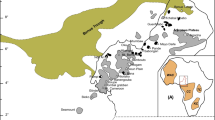Abstract
The precambrian postorogenic pluton of the Fort-Trinquet area (Northern Mauretania) is composed by a series of granitic rocks in which amphiboles are the characteristic mafic minerals. Twenty six amphiboles have been separated and chemically analysed; the optical properties and the unit-cell data are also given.
The crystallographic and chemical differences between these minerals reflect the variations in bulk composition of the host-rocks. In the plutonic suite, two igneous trends have been recognized: 1) a granitic trend (quartz monzonite-adamellite-granite) and 2) a syenitic trend (syenite-quartz bearing syenite-alkali granite). The amphiboles of the first trend belong to the tremolite-hastingsite series; they become richer in hastingsite mole with increasing proportion of quartz and decreasing Mg/(Mg+Fe) ratio in the rocks. The granitoids of the second trend are characterized by the occurrence of two amphiboles: a primary prismatic green-coloured actinolitic hornblende generally surrounded by a dark blue rim of riebeckite composition; the riebeckite may also form some acicular crystals associated to needles of stilpnomelane. These ≪coexisting≫ amphiboles would result from autometasomatic reactions which affected the rocks of the syenitic trend and which gave rise to the late alkali pegmatites where the constituent is a low arfvedsonitic riebeckite. The major substitutions involved in that amphibole transformation are Nax R3+→Cax R2+ and NaxSi→CaxAlIV.
Comparison with experimental data allows to estimate the physical conditions during the emplacement and the tardimagmatic evolution of this granitoid series.
Similar content being viewed by others
Bibliographie
Blanchet, M. L., Malaprade, L.: Méthode rapide de dosage des principaux éléments d'une roche silicatée. Chim. Anal. (Paris) 49, 11–27 (1967).
Boyd, F. R.: Hydrothermal investigations of amphiboles. Research in Geochemistry, P. H. Abelson ed. p. 377–396. New York: Wiley 1959.
Ernst, W. G.: Synthesis, stability relations and occurrence of riebeckite and riebeckite arfvedsonite solid solutions. J. Geol. 70, 689–736 (1962).
Fabriès, J.: Les formations cristallines et métamorphiques du Nord Est de la province de Séville (Espagne). Sci. Terre, Mém. n. 4, 267 pp. (1963).
Fabriès, J., Rocci, G.: Le massif granitique du Tarrouadji (République du Niger). Etude et signification pétrogénétique des principaux minéraux. Bull. Soc. Franc. Minéral. Crist. 88, 319–340 (1965).
Gagny, C.: Pétrogenèse du granite des Crêtes, Vosges méridionales, France. Thèse, Nantes, Faculté des Sciences, France, 1968, 546 pp.
Govindaraju, K.: Dosage des éléments majeurs des roches silicatées par spectrométrie photoélectrique, avec le quantomètre A.R.L., Bull. Soc. Franc. Céram. 67, 25–43 (1965).
La Roche, H. de: Sur l'expression graphique des relations entre la composition chimique et la composition minéralogique quantitative des roches cristallines, présentation d'un diagramme destiné à l'étude chimicominéraligique des massifs granitiques ou granodioritiques. Application aux Vosges cristallines. Sci. Terre 9, 293–337 (1964).
Layton, W.: Factors governing the natural and synthetic occurrences of members of the amphibole group of minerals. Neues Jahrb. Mineral. Monatsh. Dtsch. 5, 135–147 (1964).
Rocci, G.: Formations métamorphiques et granitiques de la partie occidentale du Pays Reguibat (Mauritanie du Nord). Bull. Dir. Mines et géol. A.O.F. Dakar n. 21, 2 vol. (1957),
Rocci, G.: Sur l'existence d'un complexe des granites intermédiaires et sa position dans l'ensemble des granitisations de l'Ouest africain. Compt. Rend. 248, 3588–3590 (1959).
Rocci, G.: Ages absolus, histoire et structure de l'Ouest du bouclier africain. Compt. Rend. 2, 2859–2862 (1964).
Rocci, G.: Essai d'interprétation de mesures géochronologiques, La structure de l'Ouest africain. Sci. Terre, Nancy 10, 461–478 (1965).
Rocci, G.: Les granites du couple ≪craton-zone mobile≫ au Sahara centro-occidental. Service géologique du Maroc. (sous presse) (1970).
Author information
Authors and Affiliations
Rights and permissions
About this article
Cite this article
Fabriès, J., Rocci, G. Evolution cristallochimique des amphiboles dans la série granitique de Fort-Trinquet (Mauritanie). Contr. Mineral. and Petrol. 35, 215–225 (1972). https://doi.org/10.1007/BF00371216
Received:
Issue Date:
DOI: https://doi.org/10.1007/BF00371216




